5 Garlic Growing Tips You Dont Want to Miss

Garlic is a good choice for organic gardens throughout North America. Like onions, garlic is a cool weather crop; it requires cold in order for the bulb to split into cloves and, in some cultivars, to trigger cell division. That being the case, it’s best to plant it in the late fall or early winter, two weeks before the first frost.
Here are 5 great tips to planting and growing garlic you don’t want to miss.
5 GARLIC GROWING TIPS:
1. PLANT SEED GARLIC
The germination rate for domesticated garlic seed is quite low. In fact, the seeds of most varieties are sterile, due to thousands of years of selection for certain characteristics that discourage fertility. Today, almost all garlic is propagated from cloves.
2. PLANT DEPTH OF GARLIC DEPENDING ON WINTER CLIMATES
You’ll need to start with healthy bulbs, then pop them apart into individual cloves. Plant the largest, healthiest cloves one per hole, root end down. If you expect a mild winter, an inch is deep enough; in areas with severe winters, plant them 2-4 inches deep. Fair warning: it’s best to acquire your seed garlic, as it’s called, from a local source, or it may require a 2-3 year period to adapt to your climate.
3. PLANT OATS IN GARLIC BEDS FOR NATURAL MULCH
Garlic cultivation lends itself well to mulching. Here’s an ingenious example that’s especially appropriate for areas with harsher winters: sow oats in your garlic beds in late August or early September. When it’s time to plant the garlic, cut slices through the oats to plant your cloves in. The garlic plants won’t have a problem coming up through the oats cover. The oats should die back when it gets cold, forming effective dead mulch. If it doesn’t, expect your garlic yields to be smaller, as the oats will commandeer some of the water and nutrients your garlic would otherwise use.
4. REMOVE SCAPE TO PRESERVE BULB SIZE
Most garlic plants will eventually put out a woody flowering stem called a scape. You’ll need to cut or snap it off so that the plant doesn’t waste energy on it, as the development of the scape will compromise the size of the bulb. When you remove scapes, be sure to do so on a sunny day so the wounds will dry out quickly. And don’t just throw the scapes on your compost pile—if you get them while they’re tender, they make great stir-fry or pesto. On commercial farms, they’re sold for $1-3 per pound.
5. DON’T OVER-FERTILIZE GARLIC PLANTS
One more thing: you should use a high-phosphorous fertilizer such as bat guano or fish meal to encourage growth in your garlic. However, don’t over-fertilize it, or it will become too leafy and the bulbs won’t be as large as you’d like.
Related news
 The relationship between nitrogen & organic matter
The relationship between nitrogen & organic matter Vegetable growers frequently ignore the relationship between nitrogen and organic matter when deciding on the amount of nitrogen to apply to a crop
 How to Grow Japanese Yew Shrubs
How to Grow Japanese Yew Shrubs Although Japanese yews are technically classified as conifers, they don’t produce cones, but female specimens bear red berries.
 Selecting the right nitrogen fertiliser
Selecting the right nitrogen fertiliser When it comes to vegetables, choosing the right nitrogen fertiliser is extremely important. For many US agronomists, ammonium sulphate is the fertiliser